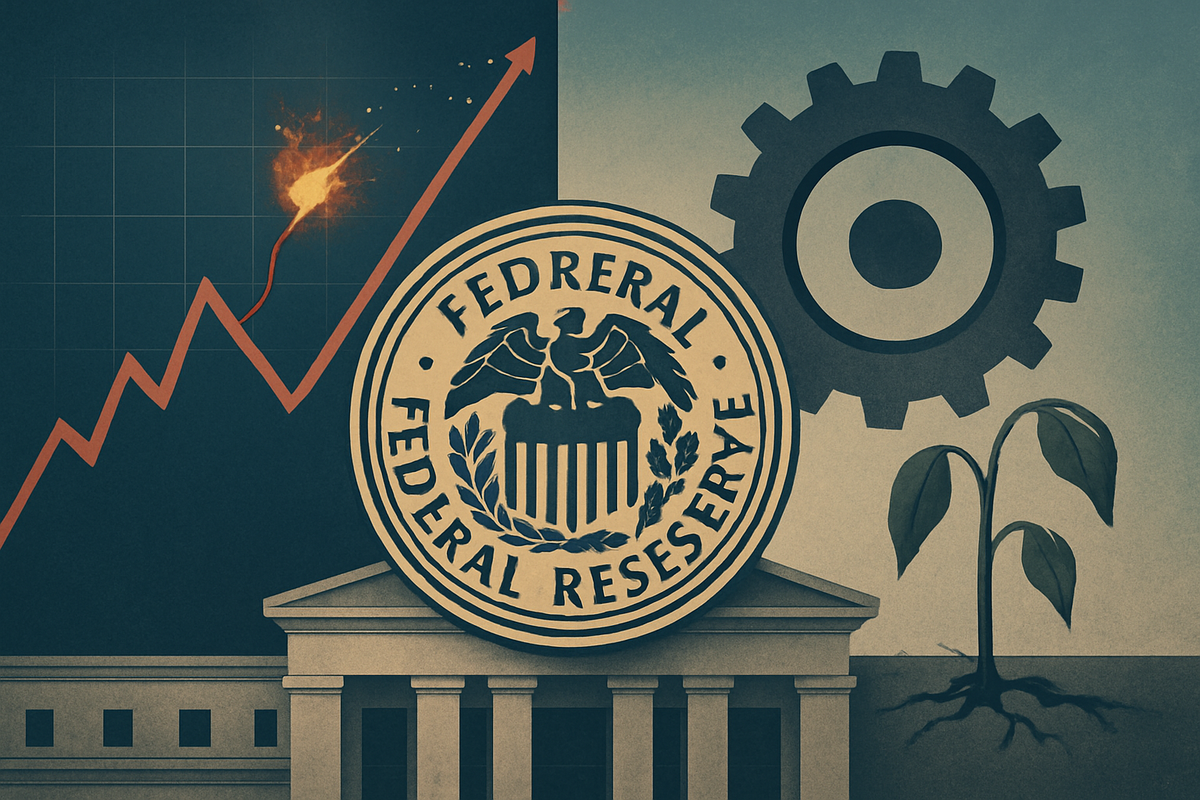
Washington D.C. – November 19, 2025 – The Federal Reserve's latest minutes, released today, reveal a central bank grappling with deep divisions over the trajectory of interest rates, significantly increasing the likelihood of a December rate pause. While a majority of policymakers foresee further rate reductions over time, a substantial number also believe that holding the federal funds rate steady in December may be "appropriate," creating a "coin-toss" scenario for financial markets. This internal disagreement stems from a delicate balancing act between persistent inflation, which remains above the Fed's 2% target, and a softening labor market, further complicated by recent disruptions to economic data.
This pivotal moment for the Fed, with the federal funds rate currently targeted at 3.75% to 4%, suggests a cautious approach. The immediate implication is a period of heightened uncertainty for businesses and consumers, as borrowing costs for mortgages, car loans, and credit cards are likely to hold steady rather than decreasing further. For savers, however, current strong savings and CD yields could persist into early 2026. Market sentiment has already shifted dramatically, with the probability of a December interest rate cut plummeting from nearly 95% a month ago to approximately 50%, indicating that traders now view a pause as equally likely.
The Fed's Tightrope Walk: Balancing Inflation and Employment
The minutes from the Federal Open Market Committee (FOMC) meeting held on October 28-29, 2025, published this Wednesday, showed that while the Fed proceeded with its second quarter-point rate cut of the year, the decision was far from unanimous. Governor Stephen Miran advocated for a more aggressive half-percentage point cut, while Kansas City Fed President Jeffrey Schmid preferred no change, highlighting the initial cracks in consensus. Crucially, the minutes indicated "strongly differing views" among the 19-member committee concerning the appropriate policy decision for the December 9-10 meeting, with many participants expressing that "it would likely be appropriate to keep the target range unchanged for the rest of the year."
This dilemma is rooted in a mixed economic picture: job gains have slowed, and the unemployment rate has edged up to 4.3%, yet inflation has remained "somewhat elevated" and above the Fed's 2% target for nearly five years, currently hovering around 3.0-3.1% for CPI and 2.8% for PCE. This persistent inflation, particularly in the services sector, is proving sticky, while the softening labor market is compelling some Fed officials to prioritize employment. The Fed has already initiated an easing cycle in 2025, with policymakers lowering the benchmark rate by a quarter of a percentage point in both September and October, bringing the federal funds rate to its current target range.
Another key revelation from the October minutes was the decision to conclude the reduction of the Fed's aggregate securities holdings, also known as Quantitative Tightening (QT), on December 1, 2025. This move is expected to allow liquidity to gradually re-enter the financial system, potentially offsetting some of the restrictive effects of higher rates. The lack of consistent economic data, partly due to a recent government shutdown delaying reports like the September jobs report (now expected on November 20, 2025), further complicates the Fed's decision-making, leaving them with less information than usual for the December meeting.
Recent statements from Federal Reserve officials further underscore the deep divisions. Governor Christopher Waller, in a November 17 speech, expressed his intent to vote for a quarter-point cut in December, citing concerns over the labor market's health and stating he is "not worried about inflation accelerating." Conversely, Kansas City Fed President Jeffrey Schmid and Dallas Fed President Lorie Logan, who both dissented against the October rate cut, have signaled opposition to a December reduction due to persistent inflation concerns. Boston Fed President Susan Collins also suggested that keeping policy rates at current levels "for some time" would be appropriate.
Corporate Fortunes in a Stable Rate Environment
A potential Federal Reserve rate pause in December 2025, maintaining a stable interest rate environment within the 3.75%-4% range after previous cuts, would create distinct winners and losers among public companies and sectors. This environment aims to balance economic stimulation with inflation management.
Potential Winners:
- Real Estate and Homebuilders: A stable or lower interest rate environment typically translates to lower mortgage rates, making homeownership more affordable. This directly benefits homebuilders like D.R. Horton (NYSE: DHI) and Lennar Corporation (NYSE: LEN), as well as residential real estate companies and related industries by stimulating growth in the housing market. Commercial real estate developers also benefit from reduced financing costs for new projects.
- Technology and Growth Stocks: Companies in the technology sector, especially growth-oriented firms, often rely heavily on borrowing to fund innovation and expansion. A stable, lower rate reduces their borrowing costs, making it easier to invest and grow. Companies like NVIDIA (NASDAQ: NVDA) and Microsoft (NASDAQ: MSFT) could see continued strong valuations as future earnings are discounted at a lower rate.
- Consumer Discretionary: With stable and lower borrowing costs on credit cards, auto loans, and personal loans, consumers will likely experience an increase in disposable income. This can lead to higher spending on non-essential goods and services, benefiting sectors such as automobiles (e.g., General Motors (NYSE: GM)), entertainment (e.g., Walt Disney Co. (NYSE: DIS)), retail (e.g., Amazon.com Inc. (NASDAQ: AMZN)), and travel.
- Small-Cap Stocks: These companies are often more sensitive to domestic economic conditions and can benefit significantly from reduced borrowing costs, which supports their growth initiatives.
- Utilities: Utility companies like NextEra Energy (NYSE: NEE) require substantial capital investments, often financed through debt. A lower and stable interest rate reduces their borrowing expenses, facilitating infrastructure investments.
Potential Losers:
- Savers and Money Market Fund Investors: A stable, lower interest rate environment means that banks are likely to decrease the rates offered on savings accounts, Certificates of Deposit (CDs), and money market accounts, leading to reduced returns for savers.
- Financials (Banks): While rising interest rates generally boost bank profitability, a pause or cut in rates can put pressure on Net Interest Margins (NIMs) for banks like JPMorgan Chase & Co. (NYSE: JPM) and Bank of America (NYSE: BAC). However, an increase in loan origination volumes due to stimulated demand for mortgages and business credit could partially offset this impact.
- Certain Defensive and Dividend-Paying Stocks: While some defensive stocks like utilities may benefit, the appeal of certain dividend-paying defensive stocks could diminish if bond yields become relatively more competitive in a stable rate environment, prompting investors seeking income to shift capital.
Wider Significance: Navigating a Complex Economic Tapestry
A December 2025 rate pause, following previous cuts, would signal a cautious approach by the Federal Reserve, suggesting they believe the current level of interest rates (between 3.75% and 4.00%) is appropriately restrictive or neutral enough to manage the dual mandate of price stability and maximum employment. This decision comes at a time when the U.S. economy is characterized by a delicate balancing act, with persistent inflation above target and a softening labor market.
This pause could indicate the Fed believes the economy is progressing well, with inflation easing and the labor market neither too hot nor too cold, without the immediate need for further adjustments. However, given the context, a pause could also raise "stagflationary risk," where higher prices coincide with slowing economic growth. This suggests the Fed is waiting to see if earlier rate cuts have had their intended effect or if further action will be required in 2026. The financial markets, which widely anticipate Fed decisions, might experience volatility if a pause is unexpected or if it is interpreted as a sign of underlying economic weakness.
In terms of broader industry trends, interest-rate-sensitive sectors like real estate, automotive, and construction might see a leveling off of the stimulus from previous cuts. The financial sector could see stabilization in their net interest margins after a period of potential compression. Technology stocks, particularly the "Magnificent 7" (e.g., Apple Inc. (NASDAQ: AAPL), Alphabet Inc. (NASDAQ: GOOGL)), have shown resilience and outperformed during the easing cycle; a pause could either sustain this trend if stability is perceived or temper it if growth concerns resurface.
Ripple effects on competitors and partners are also significant. A stable cost of capital could allow companies to continue investment plans initiated during the rate-cutting phase, leading to a more level playing field. However, if the pause is due to lingering inflation and slowing demand, it could still pressure supply chains due to reduced consumer spending or higher input costs. Internationally, if the Fed pauses while other central banks continue easing, it could influence the U.S. dollar's value, impacting trade.
Regulatory and policy implications include the Fed's ongoing focus on financial stability and its assessment of monetary policy effectiveness in addressing structural labor market issues or persistent inflation. External factors like government policy changes, including potential tariffs proposed by President Donald Trump, could fuel inflation, further complicating the Fed's efforts. Historically, pauses during easing cycles have occurred, such as in January 2025 after a three-meeting streak of cuts, demonstrating the Fed's willingness to halt cuts if inflation remains a concern, even with a softening labor market. This precedent highlights the current "tug-of-war" the Fed faces, seeking to avoid both entrenched inflation and an unnecessarily deep recession.
What Comes Next: A Path Fraught with Possibilities
Following a potential Federal Reserve December 2025 rate pause, the economic landscape will be shaped by the interplay of persistent inflation, a softening labor market, and the lingering effects of previous rate cuts. This presents a complex array of short-term and long-term possibilities.
In the short term, market volatility is a strong possibility as investors digest the news of a pause. Rate-sensitive sectors could be particularly vulnerable to reversals. The Fed's data-dependent approach means that upcoming jobs reports and inflation figures will be scrutinized even more intensely. Any signs of further labor market weakening or a more significant drop in inflation could quickly revive expectations for future cuts, while stubborn inflation might solidify the pause. Investor sentiment will be mixed; some may see it as a sign of economic resilience, while others may view it as reluctance to stimulate growth.
Longer term, the implications will heavily depend on whether the economy achieves a "soft landing" – a gradual deceleration of economic activity without entering a deep recession. If successful, equities generally perform well. However, there's a risk of a prolonged slowdown if the labor market deteriorates rapidly and persistent inflation limits the Fed's ability to ease policy further. The long-term path of inflation is critical; if tariffs continue to exert upward pressure on prices through 2026, the Fed might need to maintain a higher-for-longer stance.
Market opportunities could emerge in quality bonds, which tend to rise in price during easing cycles. Small-cap stocks could also outperform large caps if the pause is temporary and followed by further cuts, as smaller companies benefit more from cheaper borrowing. Dividend-paying stocks, particularly in the financial sector, as well as real estate, utilities, and consumer staples, could benefit if further rate cuts resume. Gold, often a hedge against uncertainty, could also see increased interest. However, challenges include persistent inflation risk, which could constrain the Fed's ability to ease further, and a continued softening of the labor market, potentially leading to reduced consumer confidence and spending.
Potential scenarios range from "Cautious Optimism," where the economy achieves a soft landing, to "Stagflationary Pressure," where inflation remains sticky and growth weakens. A "Renewed Easing Cycle" could occur if the labor market deteriorates rapidly, prompting the Fed to resume cuts in early 2026, assuming inflation is contained. A "Policy Misstep," involving overly aggressive easing that reignites inflation, is a less likely but possible outcome.
Wrap-Up: Navigating the Evolving Market
The Federal Reserve's potential decision to pause rate adjustments in December 2025 marks a critical juncture for the economy, underscoring its commitment to a data-dependent approach amidst persistent inflation (around 3.0-3.1%) and a softening labor market (unemployment at 4.3%). This move, following previous rate cuts that brought the federal funds rate to 3.75%-4.00%, signals a careful balancing act designed to guide inflation down without unduly jeopardizing economic growth. The primary takeaway is a period of recalibration, where the Fed allows previous policy adjustments to take full effect before committing to further action.
Moving forward, financial markets will likely exhibit mixed reactions. Equity markets could see stabilization if the pause is interpreted as a sign of economic resilience, or heightened volatility if concerns about persistent inflation and a slowing economy dominate. Bond markets will closely watch the yield curve, with short-term yields potentially stabilizing. The U.S. dollar's strength will depend on global monetary policy expectations, and commodity prices will react to global growth outlooks. The lasting impact of this pause could be a test of the Fed's credibility in achieving its dual mandate, potentially signaling a "new normal" for interest rates higher than pre-pandemic levels.
Investors should remain vigilant and adaptable to the evolving market environment. Key indicators to watch in the coming months include:
- Inflation Data (CPI, PCE): Any significant deviation from the current 3.0-3.1% range will be paramount.
- Labor Market Reports: Non-farm payrolls, wage growth, and unemployment claims will signal the health of the job market.
- Consumer Spending and Business Investment: These provide insights into aggregate demand and economic momentum.
- Fed Commentary: Speeches, press conferences, and FOMC minutes will offer crucial insights into policymakers' evolving views.
- Global Economic Developments: International growth, geopolitical events, and actions by other central banks can influence the Fed's calculus.
- Yield Curve Dynamics: The spread between short-term and long-term Treasury yields is a powerful predictor of economic activity.
The December 2025 rate pause, if it occurs, will not be an end to uncertainty but rather a crucial phase in the Fed's complex navigation of a challenging economic landscape. Investors who closely monitor these developments will be best positioned to adapt their portfolios and strategies for the months ahead.
This content is intended for informational purposes only and is not financial advice






